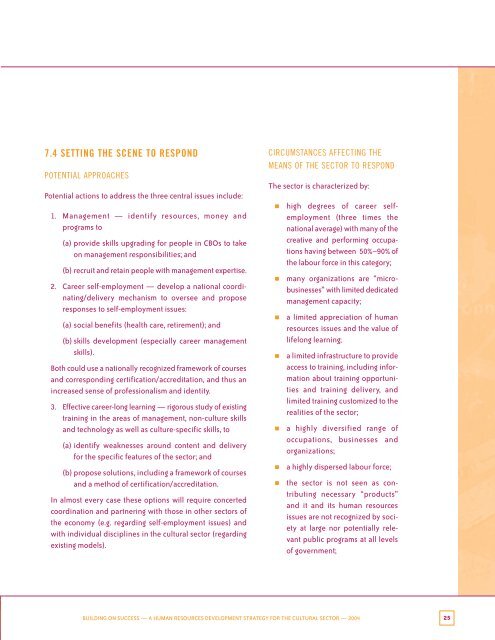Full document
Full document
Full document
Create successful ePaper yourself
Turn your PDF publications into a flip-book with our unique Google optimized e-Paper software.
7.4 SETTING THE SCENE TO RESPOND<br />
POTENTIAL APPROACHES<br />
Potential actions to address the three central issues include:<br />
1. Management — identify resources, money and<br />
programs to<br />
(a) provide skills upgrading for people in CBOs to take<br />
on management responsibilities; and<br />
(b) recruit and retain people with management expertise.<br />
2. Career self-employment — develop a national coordinating/delivery<br />
mechanism to oversee and propose<br />
responses to self-employment issues:<br />
(a) social benefits (health care, retirement); and<br />
(b) skills development (especially career management<br />
skills).<br />
Both could use a nationally recognized framework of courses<br />
and corresponding certification/accreditation, and thus an<br />
increased sense of professionalism and identity.<br />
3. Effective career-long learning — rigorous study of existing<br />
training in the areas of management, non-culture skills<br />
and technology as well as culture-specific skills, to<br />
(a) identify weaknesses around content and delivery<br />
for the specific features of the sector; and<br />
(b) propose solutions, including a framework of courses<br />
and a method of certification/accreditation.<br />
In almost every case these options will require concerted<br />
coordination and partnering with those in other sectors of<br />
the economy (e.g. regarding self-employment issues) and<br />
with individual disciplines in the cultural sector (regarding<br />
existing models).<br />
CIRCUMSTANCES AFFECTING THE<br />
MEANS OF THE SECTOR TO RESPOND<br />
The sector is characterized by:<br />
• high degrees of career selfemployment<br />
(three times the<br />
national average) with many of the<br />
creative and performing occupations<br />
having between 50%–90% of<br />
the labour force in this category;<br />
• many organizations are “microbusinesses”<br />
with limited dedicated<br />
management capacity;<br />
• a limited appreciation of human<br />
resources issues and the value of<br />
lifelong learning;<br />
• a limited infrastructure to provide<br />
access to training, including information<br />
about training opportunities<br />
and training delivery, and<br />
limited training customized to the<br />
realities of the sector;<br />
• a highly diversified range of<br />
occupations, businesses and<br />
organizations;<br />
• a highly dispersed labour force;<br />
• the sector is not seen as contributing<br />
necessary “products”<br />
and it and its human resources<br />
issues are not recognized by society<br />
at large nor potentially relevant<br />
public programs at all levels<br />
of government;<br />
BUILDING ON SUCCESS — A HUMAN RESOURCES DEVELOPMENT STRATEGY FOR THE CULTURAL SECTOR — 2004 25










